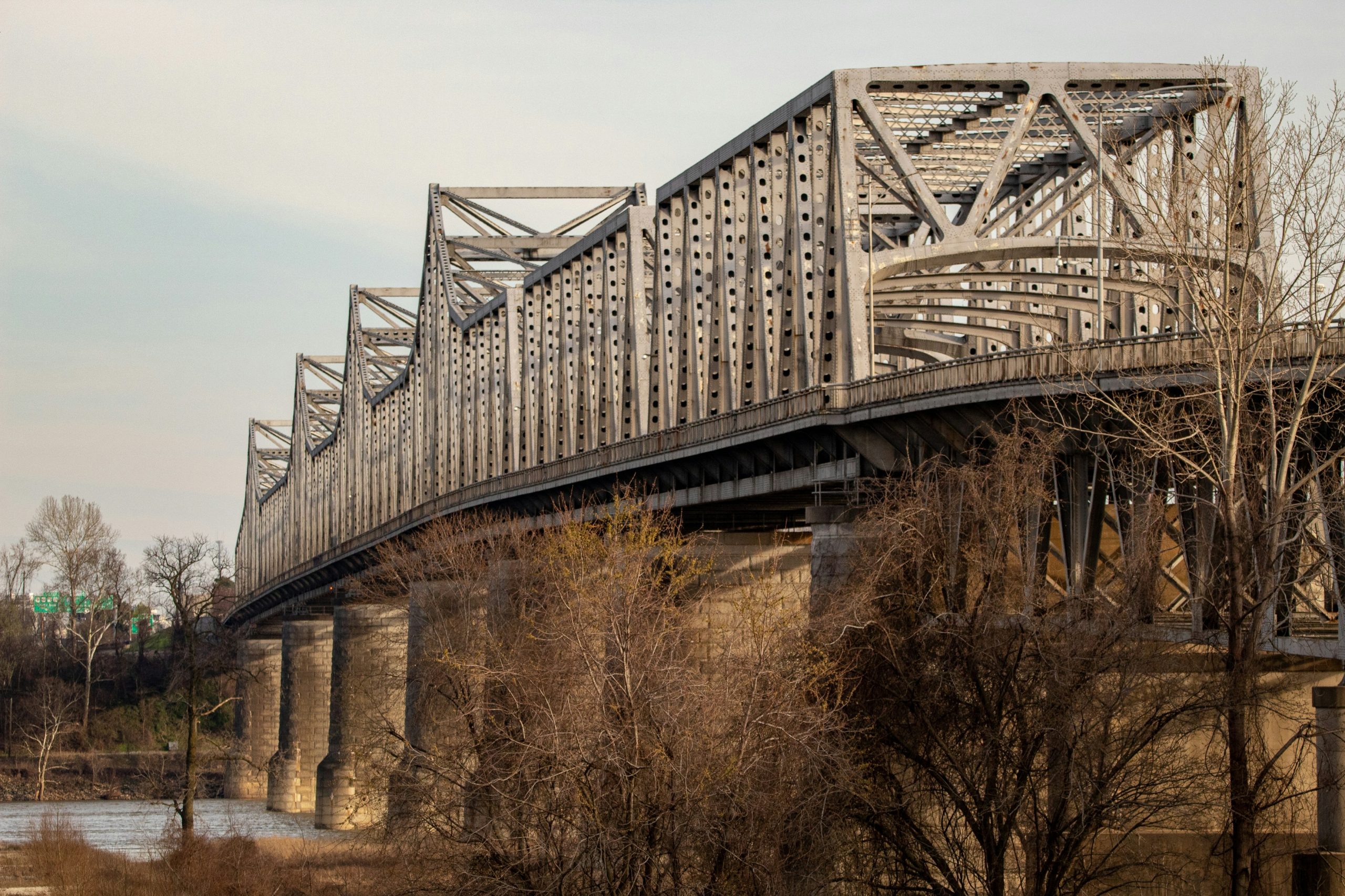Supply Chain Implications of the New Memphis and Arkansas Bridge

A historic transformation is underway with the construction of a new bridge to replace the aging Interstate 55 bridge connecting Memphis and Arkansas. This massive $800+ million investment, now nicknamed “America’s River Crossing,” marks a turning point for supply chain efficiency and resilience.
This new bridge is not merely a replacement but a lifeline for countless industries that rely on the movement of goods across the Mississippi River. This project promises to alleviate longstanding bottlenecks, enhance safety, and stimulate economic growth. In this blog post, we’ll delve into the details of this monumental project, exploring its profound implications for logistics, transportation, and the overall landscape of supply chains in the region and beyond.
The Historical Legacy of the Memphis and Arkansas I-55 Bridge
The Interstate 55 bridge, a historic landmark completed in 1949, has served as a crucial link between Memphis, Tennessee, and West Memphis, Arkansas, for over seven decades. This iconic structure, officially known as the “Memphis & Arkansas Bridge,” stretches nearly a mile across the Mississippi River. Over the years, it has witnessed the tremendous growth and evolution of American transportation and commerce, playing a pivotal role in connecting the eastern and western parts of the country.
The bridge quickly became vital for the region’s economy, facilitating the movement of goods, services, and people between the two states. It has witnessed the rise of the trucking industry, the expansion of interstate highways, and the increasing interconnectedness of the American economy. For countless travelers and truckers, the bridge has been a familiar sight and a symbol of the nation’s vast infrastructure network.
Limitations and Challenges of the Current Bridge
While the I-55 bridge has served admirably for decades, the bridge’s age and design are now presenting significant challenges. Built to the standards of a bygone era, the bridge faces growing concerns about its ability to withstand modern traffic demands and potential hazards, such as earthquakes. Its narrow lanes, designed for a time when traffic volumes were far lower, now contribute to congestion and bottlenecks, slowing the flow of goods and people. Additionally, the lack of emergency shoulders poses risks to both drivers and emergency responders in the event of accidents or breakdowns.
With the bridge serving as a major conduit for interstate commerce and travel, any disruption or delay translates to significant economic losses. The ripple effects of these disruptions could extend far beyond the immediate region, impacting supply chains and trade routes across the country.
These challenges have led to the momentous decision to construct a modern, resilient replacement for the I-55 bridge. This new structure is essential to address the current shortcomings, accommodate growing traffic volumes, and ensure the safety and efficiency of this critical transportation link for generations to come.
A New Vision for America’s River Crossing
The urgent need for a modernized I-55 bridge became undeniable after the closure of the Hernando de Soto bridge (I-40) in 2021, highlighting the vulnerability of the region’s infrastructure and prompting officials to push for an upgrade. The proposed “America’s River Crossing” is a direct response to this wake-up call, designed to address the limitations of the current bridge and fortify the region’s transportation network.
With construction activities tentatively planned to begin in 2026, this state-of-the-art bridge will not only boast wider lanes and ample emergency shoulders but will also be engineered to withstand seismic activity, a crucial safety feature given the region’s vulnerability to earthquakes.
With a focus on efficiency, the new bridge is poised to revolutionize traffic flow. Projected to accommodate approximately 64,000 vehicles daily by 2050—significantly higher than the current 48,000—it will dramatically increase capacity and reduce congestion. This will minimize delays, benefiting both commuters and the transportation industry.
The completion of America’s River Crossing bridge will mark a significant milestone in the ongoing effort to modernize and strengthen America’s infrastructure. It’s a testament to the power of collaboration, innovation, and forward-thinking, and it serves as a shining example of how strategic investments in infrastructure can create a brighter future for generations to come.
Funding and Collaboration: A Historic Investment in Infrastructure
Building a bridge of this magnitude requires significant financial investment. The projected cost for the new Memphis and Arkansas bridge sits at a substantial $900 million. However, experts caution that this figure could rise due to unforeseen challenges and inflationary pressures. As Dave Parker with the Arkansas Department of Transportation aptly noted, the final cost might even reach the billion-dollar mark.
Where is the Money Coming From?
- Federal Support: The United States Department of Transportation has committed a considerable sum of $393.75 million.
- State Contributions: Both the Tennessee Department of Transportation (TDOT) and the Arkansas Department of Transportation (ARDOT) are each contributing around $250 million.
The collaborative funding model highlights the importance of this project, not only for the immediate region but also for the entire nation. The new bridge is seen as a crucial step towards a more efficient and resilient supply chain network, capable of supporting future growth and economic prosperity.
Supply Chain Implications: A Game-Changer for Efficiency, Safety, and Growth
The replacement of the I-55 bridge is poised to have a transformative effect on supply chains that rely on this critical Mississippi River crossing. The modern design and increased capacity of the new bridge will usher in a new era of efficiency, safety, and economic growth, with far-reaching implications for the logistics and transportation industries.
Enhanced Efficiency & Reduced Costs
The new bridge will directly address the chronic congestion and delays that have long plagued the existing I-55 bridge. Here’s how:
- Unclogging the Bottleneck: The new bridge will directly address the chronic congestion and delays that have long plagued the existing I-55 bridge. Wider lanes, improved traffic flow, and the elimination of choke points will streamline the movement of goods, resulting in faster transit times and more predictable delivery schedules.
- Cost Savings for Businesses: Reduced delays and improved efficiency translate to significant cost savings for businesses. Less time spent idling in traffic means lower fuel costs and reduced labor expenses. Additionally, the ability to transport goods more quickly and reliably can lead to improved inventory management and decreased carrying costs.
- Strengthening Just-in-Time Supply Chains: The reliability and efficiency of the new bridge will be a boon for just-in-time supply chains, which rely on precise timing and minimal inventory levels. The reduced risk of delays will enable businesses to optimize their operations and minimize disruptions.
Improved Safety and Resilience
Safety is a top priority in the design of the new bridge. Its modern features will significantly enhance the safety and resilience of the supply chain:
- Minimizing Disruptions: The new bridge’s earthquake-resistant design and enhanced safety features will minimize the risk of disruptions due to car accidents or natural disasters. This resilience is crucial for supply chains, ensuring that the flow of goods remains uninterrupted even in challenging circumstances.
- Protecting Valuable Cargo: Wider lanes and emergency shoulders will contribute to a safer transportation environment, reducing the likelihood of accidents and protecting valuable cargo. This enhanced safety will provide peace of mind to businesses and contribute to a more secure
- Enhanced Visibility and Lighting: Improved lighting and visibility will further enhance safety, particularly during nighttime hours and adverse weather conditions, ensuring that truck drivers and other motorists can navigate the bridge with confidence. This will reduce the risk of accidents and contribute to a smoother flow of traffic.
Economic Growth & Expansion
The new bridge’s impact extends beyond transportation. By improving infrastructure and connectivity, it will act as a catalyst for economic growth in the region:
- Boosting Regional and National Economies: The improved efficiency and reliability of the new bridge will have a positive ripple effect on the regional and national economies. By facilitating the smooth flow of goods, the bridge will support economic growth and create new opportunities for businesses.
- Attracting New Businesses: The enhanced transportation infrastructure will make the region more attractive to businesses looking to establish or expand their operations. This could lead to increased investment, job creation, and a more vibrant economy.
- Expanding Market Reach: The improved connectivity offered by the new bridge will enable businesses to access new markets and expand their customer base. This will open up new opportunities for growth and contribute to a more dynamic and interconnected supply chain network.
A Transformative Investment with Far-Reaching Impact
The America’s River Crossing bridge project signifies a bold commitment to progress, resilience, and economic vitality. This monumental endeavor will reshape transportation and logistics in the region, alleviating congestion, enhancing safety, and fostering economic growth. It heralds a new era of connectivity and opportunity for businesses and individuals alike.
The completion of this bridge marks a significant milestone in modernizing America’s infrastructure. It showcases the power of collaboration, innovation, and strategic investment in shaping a brighter future.
As businesses adapt to the evolving supply chain landscape brought about by this new infrastructure, it’s crucial to have the right strategies and expertise in place. If your business needs guidance and support in optimizing your supply chain and harnessing the full potential of this transformative project, Armstrong is here to help. Our team of experienced professionals can provide tailored solutions to streamline your operations, enhance efficiency, and ensure your supply chain remains resilient and adaptable in the face of change. Contact Armstrong today to explore how we can help your business thrive in this new era of connectivity and opportunity!
